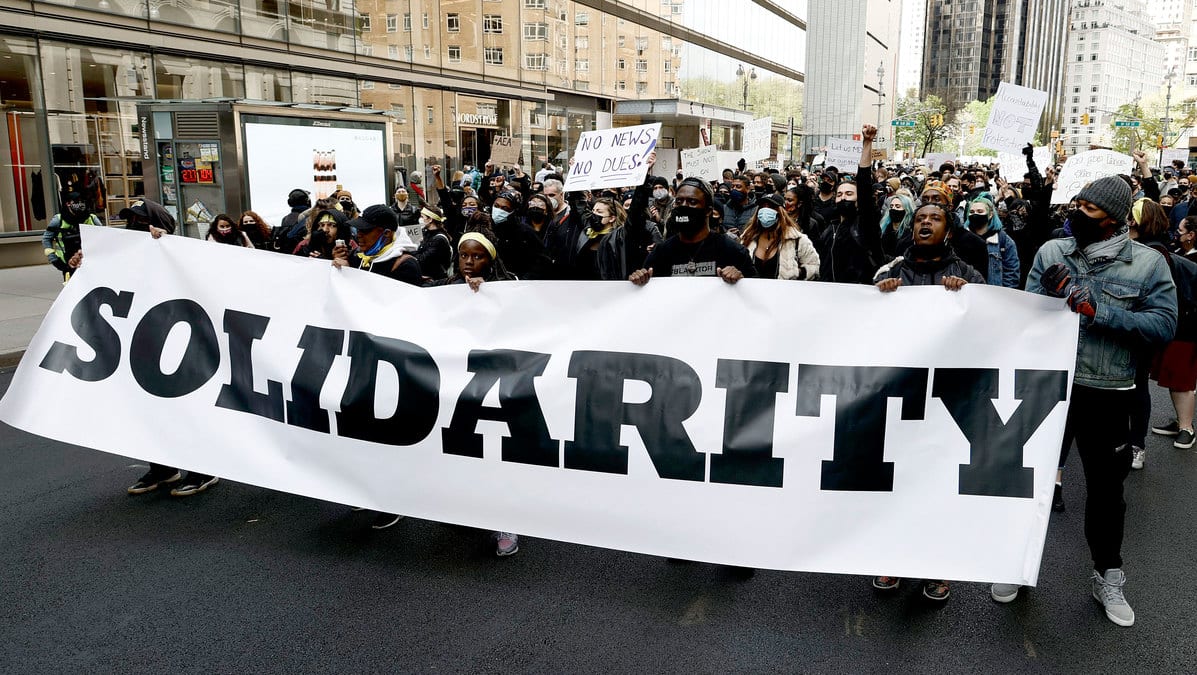As nationwide protests roiled in the streets last June, Broadway Advocacy Coalition organized #BwayforBLM, an online forum whose streaming audience of more than 5,000 would have exceeded four of Broadway’s largest theaters. An entire industry, and especially its white leaders, seemed called to account for anti-Black racism, over three nights of testimony and dialogue from Black theater artists and professionals.
In the year since, industry activists and leaders say that a fair amount of work has been done to expose and address white supremacy in the structures of American theater.
Nearly 8,000 industry members ultimately signed BAC’s Public Accountability Pledge last year, committing to the ongoing work of dismantling internalized and systemic racism. Yet the online audience at a follow-up forum Tuesday night would have fit comfortably into an intimate venue of fewer than 300 seats.
The 90-minute, panel-based livestream, titled What Now Part II: From Ally to Action, came as the pandemic continues to recede, theater is on the verge of reopening, and the fury of last summer may seem like a distant memory to some.
The time for wake-up calls is over, and the hope is that real work is being done behind the scenes.
As reported by The New York Times, a recently published study by the Asian American Performers Action Coalition shows just how urgently change is needed. At 18 major nonprofit theaters, analyzed in the 2018-19 New York theater season, 100 percent of artistic directors were white, as were 88 percent of board members, the Times reported. “On Broadway, 94 percent of producers were white, as were 100 percent of general managers.”
The study found that 58.6 percent of the roles during the 2018-19 season went to white actors, 29 percent to Black actors, 6.3 percent to Asian American actors, 4.8 percent to Latinx performers, 1.3 percent to MENA (Middle East and North Africa) actors, 0 percent to Indigenous actors, and 18 percent to BIPOC actors who identified as mixed race. White actors played 80 percent of all lead roles in musicals, and 89.7 percent of all lead roles in plays.
What Now Part I was held in February, before vaccine momentum led to a concrete promise of live theater’s return. Part II presented a rare and curious display of white industry leaders talking about, or often around, the practicalities of anti-racist learning and practices, in their own sort of public performance.
The forum was meant as a “call-in” for other white industry professionals to learn by example, a marked and logical contrast from the intentions of #BwayforBLM.
“When charged to envision this forum, I knew what it couldn't be, and that was a space to continue to ask Black people to recount stories of trauma, to have them continue to explain the most overt aspects of the work for an audience that may or may not believe them,” said Zhailon Levingston, BAC’s director of industry initiatives, at the forum’s start.
Borrowing language from anti-racist organizer Milta Vega-Cardona, Levingston said the forum was designed to hold white industry leaders in accountable relationships with people of color.
Each of the three panels focused on a tenet of white supremacy that its participants, all-white industry leaders, had purported to address in their work toward anti-racism.
Paternalism was defined in the first panel as decision-making processes that are only understood by those with power and unclear to those without. That’s an apt way to describe the work of a casting director, and Benton Whitley of Stewart Whitley Casting didn’t offer any sort of radical solution or propose upending the audition process.
Whitley spoke about his company’s consultations last year with performer and activist Brandon Michael Nase, founder and executive director of Broadway for Racial Justice. “I’m pretty sure my first question was, ‘What do you have to say about people who say that you are racist, and you have committed harm to them?’” Nase recalled. “I could see that [Whitley and casting partner Duncan Stewart] were nervous. But I said, ‘This is the work, there’s going to be nerves, people are going to get it wrong, and you have to wade through those waters.’”
A second panel addressed the white supremacist principle of power hoarding, or feeling threatened by the suggestion of organizational change. “We have to learn how to use our power to make change so that we share our power,” said Susan Sturm, BAC’s policy and research director and a law professor at Columbia University.
Allie Lalonde, producing director of the TEAM, a Brooklyn-based ensemble committed to American stories, talked about the not-for-profit’s efforts toward diversifying since its founding by all-white artists in 2004. Lalonde emphasized compensation for labor, transparency in communication, and scheduling collaboratively as strategies that the TEAM has undertaken to foster greater equity.
Hadestown producer Mara Isaacs pointed to the structural constraints of commercial theater, including legal, financial, and spatial, that broader change has to navigate within. She said a task force including members from all aspects of the Hadestown company has been assembled to identify what interventions toward greater equity and inclusion may be warranted as the production readies its return to Broadway on September 2.
“I want to be careful not to overstate an accomplishment,” she said. “We’ve laid the foundation with our values and intentions, and we’ve articulated those to the people around us. And it’s actually by articulating the values that I hold myself accountable.”
Nicole Johnson, creator of the EDIFY Dismantling Systemic Oppression Program, then briefly introduced her five-step program to dismantle systemic oppression and train white allies. Two trainees in the midst of their work with Johnson spoke about their experience: veteran Broadway producer Diana DiMenna, who’ll have Girl From the North Country and Thoughts of a Colored Man on Broadway this season, and Zachary Prince, a self-professed go-to standby performer who appeared on Broadway in Honeymoon in Vegas.
Both touched on the third tenet of white supremacy addressed in the forum, perfectionism, or pointing to inadequacy as an excuse not to engage. That bias can be applied to work by non-white artists, and to oneself—not undertaking anti-racist training, for example, if you don’t feel like the perfect spokesperson. DiMenna and Prince concluded the panel inviting viewers to sign up for EDIFY training, singing its praises in vivid terms (“all of that went from my head to my guts,” DiMenna said of intellectual resistance to white supremacy she now feels she can put into action).
As a “call in” for white industry leaders in the audience, who included Come From Away producer Sue Frost and Hello, Dolly! star Gavin Creel, the evening seemed to set a reassuring example, with a lineup of peers who were willing to take the hot seat and accept some measure of public accountability. They hadn’t made it look easy, though it didn’t look all that hard, either.
Because it’s impossible to witness anyone unlearn racist thinking and behavior, we can only take them at their word. And like theater itself, interpretation was subjective.
After the forum, viewers were invited to a Zoom meeting to hear more about anti-racist training, and a separate, much smaller breakout room was opened specifically for non-white attendees, to discuss what we saw, how we felt, and what more we wanted from white allies. We numbered only a handful.
Skeptical, overwhelmed, and weary were a few of the feelings we tossed into the room, our cameras on for the first time that night. We wanted confessions and apologies; some demanded resource-sharing and compensation. I said it had felt awkward, even as a reporter, to watch a series of white panelists talk to each other about anti-racism, seeming to atone without really admitting what they may have been guilty of.
I recognized that we weren’t the forum’s target audience, and thought, optimistically, that maybe those who were had taken these examples to heart. The rest of us were tired and ready to put down the work, at least for tonight.

